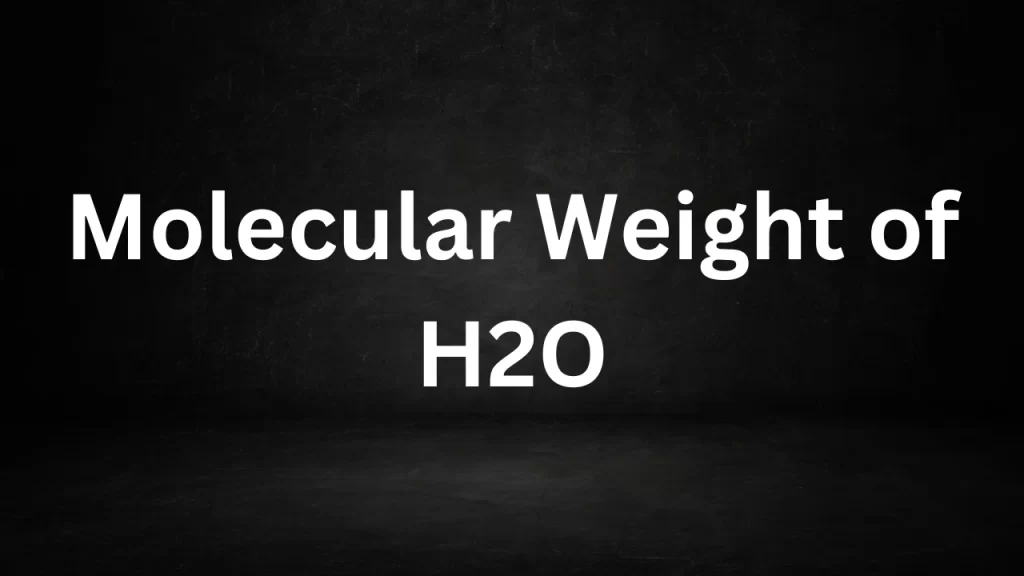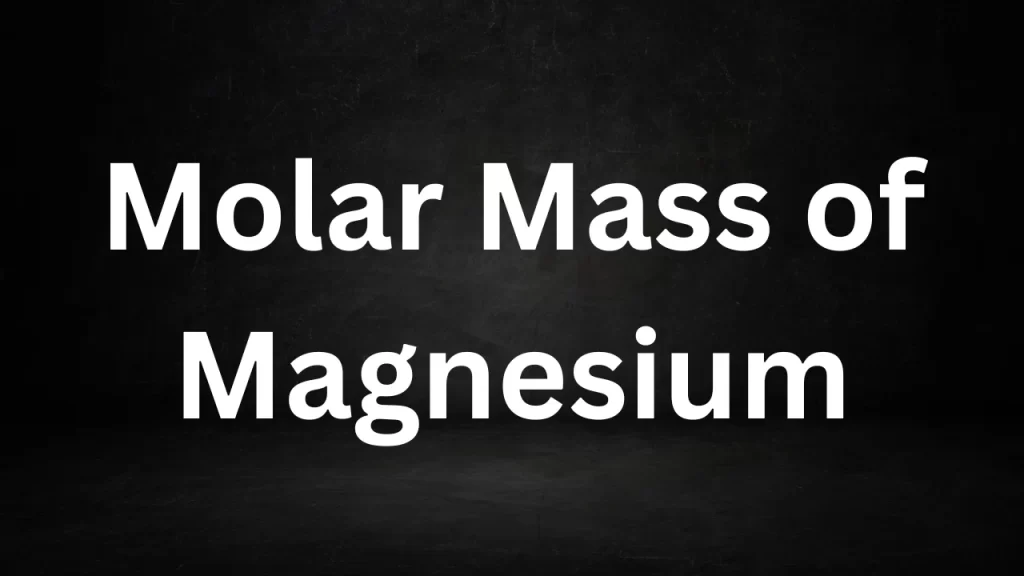Tag: mg no3 2.6 h2o molecular weight
Molecular Weight of H2O
Molecular Weight of H2O: Water, Earth’s most abundant and vital substance, consists of molecules possessing a distinct molecular weight critical for all life forms.
Understanding the molecular weight of water, represented as H2O, is fundamental not only in chemistry but also in various scientific and practical applications.
This article delves into the concept of H2O’s molecular weight, its calculation, and its importance across various fields of science and industry.

Molecular Weight of H2O
The Composition of Water:
Water, with the chemical formula H2O, consists of two hydrogen atoms (H) covalently bonded to a single oxygen atom (O). These atoms come together to form a water molecule. This molecular arrangement gives water its unique properties, such as its ability to dissolve a wide range of substances and its high heat capacity.
Calculating the Molecular Weight of H2O:
The molecular weight of a substance is defined as the mass of one mole of that substance, expressed in grams per mole (g/mol). To calculate the molecular weight of H2O, we consider the atomic masses of its constituent elements, hydrogen (H) and oxygen (O).
- The atomic mass of hydrogen (H) is approximately 1.01 g/mol.
- The atomic mass of oxygen (O) is approximately 16.00 g/mol.
To find the mole weight of H2O, we add the atomic masses of two hydrogen atoms and one oxygen atom:
Mole Weight of H2O (g/mol) = (2 × Atomic Mass of Hydrogen) + (1 × Atomic Mass of Oxygen)
Mole Weight of H2O ≈ (2 × 1.01 g/mol) + (1 × 16.00 g/mol) ≈ 18.02 g/mol
So, the mole weight of H2O (water) is approximately 18.02 g/mol.
Significance of Molecular Weight in Chemistry:
- Stoichiometry: Mole weight is crucial in stoichiometry, which involves determining the quantities of reactants and products in chemical reactions.
- Molarity: In chemistry, molarity (M) is a measure of the concentration of a substance in a solution. Molecular weight serves as a key factor in calculating molarity, a measure expressed as moles per liter (mol/L).
- Chemical Equations: Mole weight plays a vital role in balancing chemical equations to ensure the conservation of mass.
Real-World Applications:
- Laboratory Work: Chemists and researchers use the molecular weight of substances like water in laboratory experiments and analyses.
- Pharmaceuticals: Molecular weight is critical in pharmaceuticals for dosage calculations and drug formulation.
- Environmental Science: Understanding the molecular weight of water is essential in environmental science for assessing water quality and pollutant concentrations.
Conclusion:
The mole weight of H2O, approximately 18.02 g/mol, is a fundamental concept in chemistry and has broad applications in various scientific and practical fields. Whether in the laboratory, pharmaceutical industry, or environmental science, knowing the molecular weight of water is essential for precise measurements and calculations. It is a reminder of the simple yet profound principles that govern the behavior of substances at the molecular level, shaping our understanding of the world around us.
Read More
- Molecular Weight Of K2Cr2O7
- Molecular Weight Of Phosphorus
- Molecular Weight Of SO2
- Molecular Weight of Na2CO3
- Molecular Mass Of Sodium
Frequently Asked Questions (FAQs) on Molecular Weight of H2O
Q1: What is the molecular weight of H2O (water)?
A1: The mole weight of H2O, which is water, is approximately 18.02 grams per mole (g/mol). This value is calculated by summing the atomic masses of two hydrogen atoms (H) and one oxygen atom (O) in a water molecule.
Q2: Why is knowing the molecular weight of H2O important?
A2: Understanding the mole weight of H2O is crucial in various scientific and practical applications. It is used in chemistry for stoichiometry, molarity calculations, and balancing chemical equations. In fields like environmental science and pharmaceuticals, it helps in precise measurements and dosage calculations.
Q3: Does the molecular weight of H2O change with temperature or pressure?
A3: The molecular weight of H2O remains constant regardless of temperature or pressure. It is a fixed value based on the atomic masses of hydrogen and oxygen.
Q4: How is the molecular weight of H2O calculated?
A4: The mole weight of H2O is calculated by adding the atomic masses of its constituent elements. The atomic mass of hydrogen (H) is approximately 1.01 g/mol, and the atomic mass of oxygen (O) is approximately 16.00 g/mol. Therefore, for water (H2O), it is approximately 18.02 g/mol.
Q5: Can the molecular weight of H2O vary in different types of water?
A5: The mole weight of H2O is the same for all types of water, including distilled water, tap water, and seawater. It is a constant value based on the chemical composition of water, which consists of two hydrogen atoms and one oxygen atom per molecule.
Molar Mass Of Magnesium
Molar Mass Of Magnesium: Magnesium, a versatile and essential element, holds a significant place in the periodic table.
Its role in various natural processes, industrial applications, and biological systems makes it a subject of great interest in the world of chemistry. In this article, we’ll explore the concept of the molar mass of magnesium, understand its significance, and uncover the atomic weight of this mighty element.

Molar Mass Of Magnesium
Understanding Molar Mass
Before we delve into the specifics of magnesium, let’s establish what molar mass signifies. Molar mass, often referred to as molecular weight or atomic weight, is a fundamental concept in chemistry. It represents the mass of a substance in grams per mole (g/mol) and is expressed in unified atomic mass units (u) or atomic mass units (amu).
The molar mass is calculated by summing the atomic masses of all the atoms in a chemical compound, considering their respective proportions. It serves as a bridge between the microscopic world of atoms and molecules and the macroscopic world of measurable quantities in chemistry.
The Atomic Structure of Magnesium
Magnesium, with the atomic symbol Mg and atomic number 12, is a light, silvery-white, and highly abundant element in the Earth’s crust. It falls within Group 2 (Group IIA) on the periodic table, a category recognized as the alkaline earth metals. Magnesium’s atomic configuration exhibits the following features:
Atomic Number: 12 (indicating the number of protons in the nucleus)
- Atomic Mass: Approximately 24.31 atomic mass units (u)
- Electron Configuration: [Ne] 3s² (indicating its electron arrangement)
- Number of Electrons: 12 (equal to the number of protons in a neutral atom)
Calculating the Molar Mass of Magnesium
The mol mass of magnesium is determined by summing the atomic mass of a single magnesium atom. Since magnesium exists as individual atoms in its elemental form (Mg), the mol mass is equal to its atomic mass. The atomic mass of magnesium is approximately 24.31 u.
Therefore, the mol mass of magnesium (Mg) is approximately 24.31 g/mol. This numerical value finds application in diverse chemical calculations, including the determination of magnesium quantities in a given sample and assessing the composition of chemical compounds containing magnesium atoms.
Significance of the Molar Mass of Magnesium
The mol mass of magnesium is of great importance in several domains:
1. Chemical Reactions: In stoichiometry, the molar mass plays a vital role in determining the quantities of reactants and products involved in chemical reactions. It enables chemists to balance chemical equations and calculate the mass of substances consumed or produced.
2. Laboratory Analysis: When conducting experiments involving magnesium, scientists and researchers need to know its molar mass to make precise measurements and ensure accurate results.
3. Industrial Applications: Industries that utilize magnesium and its compounds, such as the automotive and aerospace sectors, rely on the molar mass for quality control and product development.
4. Environmental Studies: Environmental scientists use the molar mass of magnesium to analyze soil composition, study groundwater chemistry, and assess the impact of magnesium-containing substances on ecosystems.
5. Dietary Considerations: Magnesium is an essential mineral in the human diet, and its molar mass is relevant for nutritional assessments and dietary recommendations.
Conclusion: Magnesium’s Atomic Weight Unveiled
In conclusion, the molar mass of magnesium, approximately 24.31 g/mol, is a fundamental parameter in chemistry. It represents the atomic weight of this versatile element, empowering scientists, researchers, and industries to explore its diverse applications. Beyond the lab, magnesium’s importance extends to advancing science, technology, and enhancing our comprehension of the natural world.
Read More
- Law Of Conservation Of Energy
- Difference Between Equinox And Solstice
- Molecular Weight Of K2Cr2O7
- Molecular Weight Of Phosphorus
- Molecular Weight Of SO2
Frequently Asked Questions (FAQs) Molar Mass Of Magnesium
1. What is the molar mass of magnesium?
The mol mass of magnesium (Mg) is approximately 24.31 grams per mole (g/mol).
2. How is the mol mass of magnesium calculated?
The mol mass of magnesium is calculated by summing the atomic mass of a single magnesium atom. In the case of magnesium, the atomic mass is approximately 24.31 atomic mass units (u), which is equivalent to 24.31 g/mol.
3. Why is the mol mass of magnesium important in chemistry?
Magnesium’s molar mass is vital for chemical calculations like stoichiometry, aiding in balancing equations and precisely measuring reactants and products.
4. Is the mol mass of magnesium used in industries and manufacturing processes?
Yes, industries that utilize magnesium or magnesium-containing compounds rely on the mol mass for quality control, product development, and ensuring the proper composition of materials.
5. How does the mol mass of magnesium impact environmental studies?
Environmental scientists use the mol mass of magnesium to analyze soil composition, assess groundwater chemistry, and study the environmental impact of magnesium-containing substances.